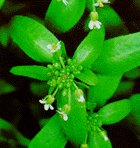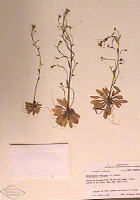 Plant
Model Systems
Plant
Model Systems 
Picture 1 courtesy of http://www.i-s-b.org/news00e.htm. Picture 2 courtesy of http://www.nybg.org/pr/report3.html. Permission pending on both images.
 Plant
Model Systems
Plant
Model Systems 
Picture 1 courtesy of http://www.i-s-b.org/news00e.htm. Picture 2 courtesy of http://www.nybg.org/pr/report3.html. Permission pending on both images.
For plant biologists, researching and understanding the genetics of all the plants of interest in the world would take forever. Therefore, scientists use model plants as a basis for research, and then apply what they have learned to other plants. A good model plant for genetic research should meet the following criteria:
Using this criteria scientists have chosen a few species on which to focus their research. One model plant receiving a lot of attention is the weed Arabidopsis thaliana. Arabidopsis is a dicot and part of the mustard family, and is found naturally throughout much of the world. It has a relatively small genome that contains about 20,000 genes organized on five chromosomes(Arabidopsis 2002). The life cycle of Arabidopsis is six weeks, and it grows to a height of 15 to 20 cm. These factors make it an ideal model plant.
Beyond those simple requirements, Arabidopsis is useful because many of the methods to be discussed in this seminar can be successfully applied to Arabidopsis in order to analyze the DNA sequence. Using various techniques, the Arabidopsis Genome Initiative (AGI) and the Arabidopsis Functional Genomics Consortium (AFGC) have mapped the Arabidopsis genome. The entire genome was completed in 2000, 4 years ahead of schedule (van Buren 2002). The AFGC used both microarray and gene knockout in order to identify genes, while AGI used a handful of other techniques. These included BAC sequencing, hybridization with YACs and chromosome walking. Maps of the Arabidopsis chromosomes can be found at The Arabidopsis Information Resource (TAIR).
Now that the genome of Arabidopsis has been sequenced and mapped, the information can be used to identify equivalent genes in other plants. Projects are under way to create databases where all the information on Arabidopsis genetics can be easily accessed. Thousands of different mutant strains of Arabidopsis have been identified and are available in order to find homologous genes in other species. By knowing the function of Arabidopsis genes scientists have come one step closer to understanding other plants of agricultural and medical importance.
Bibliography
This site was created by Tara Maloney for BIO 361, Genetically Modified Organisms
Seminar, Davidson College. Click here to go to Davidson College Website:![]()
or here to go to the Davidson Biology Website:![]()
© Copyright 2002 Department of Biology, Davidson College, Davidson, NC 28035
Send comments, questions, and suggestions to: tamaloney@davidson.edu